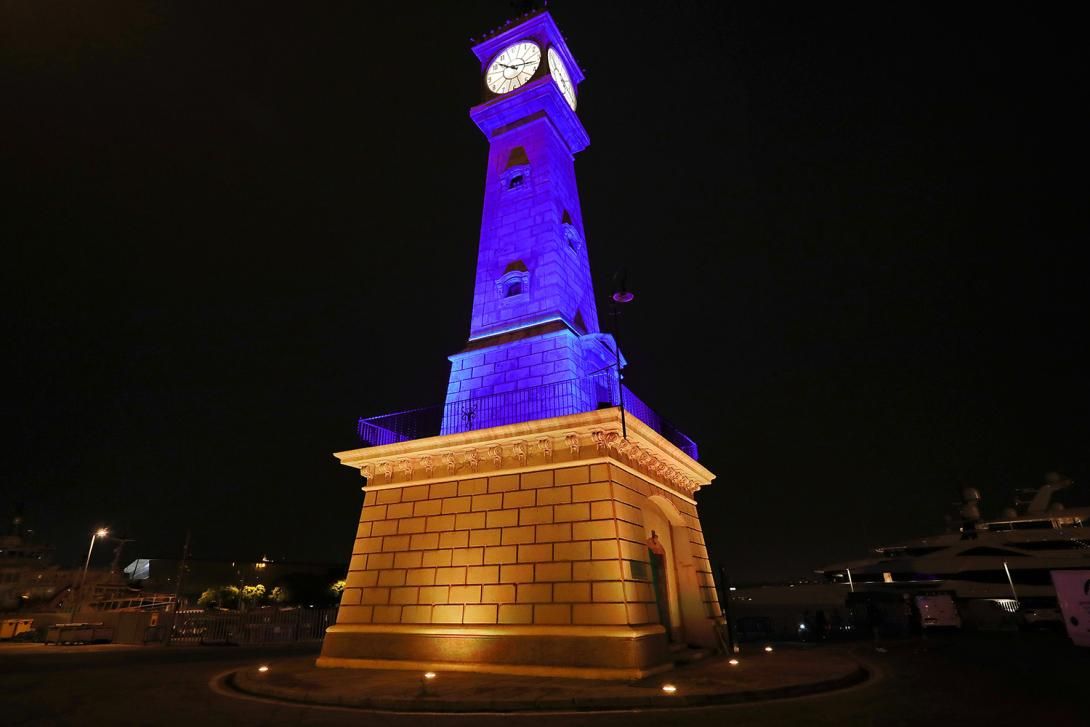The Clock Tower celebrates its 250th anniversary
An exhibition installed at the Portal de la Pau tells the story of this unique tower, which was built as a lighthouse and has become an icon of the Port and Barcelona.
Damià Calvet: “One of our tasks is to preserve the port's heritage, since this heritage belongs to everyone.”

The Port of Barcelona's Clock Tower celebrates its 250th anniversary this year with an exhibition and a series of events to inform the public about its history. The celebration coincides with the refurbishment of the Fishermen's wharf, which will begin this year as a way of guaranteeing the future development of fishing activity, while opening these spaces to the public.
The 250th anniversary commemoration ceremony was held this evening, and was attended by Damià Calvet, president of the Port of Barcelona, and Joan Alemany, a historian specialising in maritime and port matters.
In 1751, construction began on a light tower on the tip of the seawall that was being built in the Port of Barcelona, which at that time stretched as far as this point. Once work was completed, the new lighthouse entered service in 1772.
The lighthouse was neoclassical in style and consisted of a square base, a truncated pyramidal tower and a lamp on top of the building. The Port of Barcelona tower was one of only three stone lighthouses in operation in Spain, as stated in the General Plan for Maritime Lighting of the Coasts and Ports of Spain, prepared by the Special Commission of Lighthouses, approved in 1847.
Enlargements to the Port during the 19th century left the lighthouse further and further removed from the entrance mouth, and the entry into service of the Llobregat lighthouse in 1852 led to proposals to shut down and demolish the tower at the beginning of the last century. However, the Port Works Board decided to replace the lamp with a four-sphere clock that marked the time for sailors, port workers and residents of the la Barceloneta district and the whole city.
This lighthouse was a prominent building on the Barcelona coast during the eighteenth and nineteenth centuries, which is how it came to be used by two Frenchmen between 1792 and 1798, mathematician and astronomer Jean-Baptiste Joseph Delambre and geographer and astronomer Pierre Méchain, to measure the length of the meridian arc, from Dunkirk to Barcelona, results that served to establish the metric system. Later, the Roads, Canals and Ports engineer Ildefons Cerdà took it as a reference to design the Avenues called Paral·lel and Meridiana within his Reform and Enlargement Plan of Barcelona of 1859.
Opening the Fishermen's Wharf to the public
The Clock Tower, located on the current Fishermen's Wharf, is today an icon of Barcelona's most maritime character, and which will soon be accessible to the public. The Port is currently immersed in a project to completely overhaul Barcelona's various fishing facilities, with two objectives in mind: firstly to guarantee the future development of fishing activity in Barcelona under sustainability and competitiveness criteria, and secondly to open this area of the Old Port to the general public.
The €8 million budget works under this project will begin this year and include building the future fish market, a building covering 3,233 m2, the new ice factory, which entered service at the end of 2016, and the urban development of the surrounding area, of 24,103 m2. A walkway, which will start out from next to the Clock Tower and run alongside the entire building, will allow visitors to observe the activity inside the market, particularly the fish auction.
Port of Barcelona President Damià Calvet explained that “we aim to develop a sustainable, culturally attractive port-city that is a focus of knowledge and talent in the nautical and maritime sector, a benchmark in innovation, inclusive for all citizens and, very especially, for the surrounding districts”. In this context, Calvet emphasised that “one of the Port's tasks is to preserve the port's heritage, since this heritage belongs to everyone. We are achieving this in historic buildings, such as the lighthouses that depend on the Port of Barcelona, signing agreements with the city councils of the places they are located, so that they can be opened up to the public. And this is what we have done with the Clock Tower, where we have fully upgraded it both inside and out, while attempting to preserve the original elements as much as possible, which includes the restoration of the second mechanism of the clock.”
The Port of Barcelona has organised a temporary exhibition, with the participation of the historian Joan Alemany, presenting various historical images and explaining the history of the Clock Tower. This exhibition will be set up in the Portal de la Pau.
The new lighting of the Clock Tower was also lit for the first time at the event, projecting the colours of the Ukrainian flag in solidarity with the country. These also coincide with those of the flag of the la Barceloneta district.



